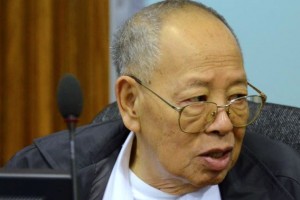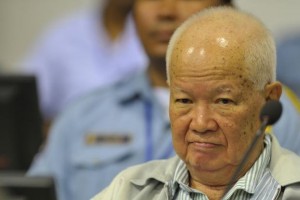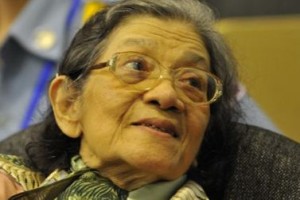An Australian prosecutor’s push to use so-called “torture confessions” in UN sponsored tribunal hearings has created a storm of controversy in international legal circles.
The UN Convention Against Torture bans prosecutors from using torture confessions, except as proof the prisoner was being tortured, and international legal experts say such tainted evidence has never been used in a legitimate international court or tribunal. They fear an ominous legal precedent is in the making.
Even the US military commissions, established to try terror suspects, do not permit torture confessions. In Australia, the case against Jack “Jihad” Thomas was dismissed in 2006 because his confession in Pakistan was found to be coerced.
Australian Bill Smith is the co-leader of the team prosecuting the four most senior living Khmer Rouge leaders. He and his Cambodian counterpart at the Khmer Rouge tribunal in Phnom Penh want to use certain confessions made by prisoners tortured in the city’s notorious S-21 prison, also known as Tuol Sleng.
Smith says the torture confessions will bolster the case against the Khmer Rouge leaders Nuon Chea, Ieng Sary and his wife Ieng Thirith, and Khieu Samphan. All elderly, all four presided over a regime where torture became routine, and none of them has confessed to any wrong-doing.
More than 14,000 prisoners were held at the S-21 prison by the paranoid regime. Most were tortured, with whips, beatings, electric shocks, pliers and water immersion. Most provided pitiful and often fictional confessions, many admitting to fanciful sins, such as working for the CIA, the KGB or the north Vietnamese. All but a handful were summarily executed, usually with an iron bar to the back of the neck, their bodies kicked into pits in the killing fields.
The UN Convention Against Torture, dating from 1975, is designed to prevent or limit torture. Both Cambodia and Australia are signatories. Article 15 says: “Each State Party shall ensure that any statement which is established to have been made as a result of torture shall not be invoked as evidence in any proceedings, except against a person accused of torture as evidence that the statement was made”. In other words, the substance of the confession is never to be used, even against the torturers.
But Smith tells The Australian that many of the torture confessions in question were annotated or initialled by the torturers and those who ordered the torture, proving their complicity, while other confessions contain useful information provided when the prisoners arrived at the prison, before they were tortured. Small parts of a further selection of torture confessions would be used to corroborate non-torture related evidence, or as leads to other non-torture related evidence. They would only be used to establish already known facts. “In this context, the use of the documents as evidence discourages the use of torture rather than encourages it, which is the core goal of the Convention Against Torture,” he says.
The prosecution wants to use a passage from the confession of Hu Nim, which ends with the desperate sentence: “I am not a human being, I am an animal.” Before his arrest on suspicion of treachery, Hu Nim had been the Khmer Rouge information and propaganda minister, privy to many of the lesser known machinations of the regime that ruled Cambodia for nearly four years in the 70s; when nearly 1.7 million Cambodians, perhaps a fifth of the population, died or were killed. The relevant part of Hu Nim’s confession, the prosecution says in a legal submission, “states known facts as to the rank and position of upper brothers (within the regime)”.
An Australian judge will be crucial to the final decision on whether to allow so these called “torture confessions” in the case against the four defendants, known as Case 2. The Tribunal’s investigating judges on Case 2, who have been compiling evidence, have already formally rejected a defence request to disallow torture material. Lengthy written legal arguments from both the prosecution and the defence lawyers are now before the Pre-Trial Chamber, where one of the presiding judges is Australian Rowan Downing, another of the judges is Dutch and the remaining three are Cambodian. The Chamber judges are expected to hand down a decision on the matter within weeks, and the trial of the four Khmer Rouge leaders is expected to begin next year.
The legal submissions have yet to be publicly released but they have been obtained by The Australian. The defence lawyers for Ieng Thirith, Briton Ms Diana Ellis and Cambodian Ms Phat Pouv Sang, argue that Cambodia is a signatory to the UN Convention Against Torture, that the Cambodian constitution bans confessions obtained by force, and that the Khmer Rouge tribunal should set an example for the Cambodian legal profession. “It is a fundamental rule of international law that evidence obtained under torture is inadmissible in criminal proceedings,” the defence lawyers write. “The use of evidence obtained in this way is excluded regardless of its potential, truthfulness, accuracy and reliability, to reflect the repugnance of civilised nations to the use of barbaric methods.”
Father Frank Brennan, the lawyer and human rights advocate who has been in the spotlight this year as chair of the committee reporting on a national charter of human rights, agrees that article 15 of the Convention Against Torture is clear. “Even against a torturer, you cannot use material obtained under torture as evidence of the truth of statements made under torture,” he says. “You can only use the material as evidence that a statement was made.”
He offers the example of a tortured prisoner who provides a list of 20 ‘traitors’. Those names could be tendered as evidence in the trial of the torturer, or the person who ordered the torture, but only to demonstrate the list had been provided by the victim of torture. “You would need to provide evidence from elsewhere about whether or not any of the 20 fitted the profile of ‘traitor’ and you would need to provide evidence untainted by torture to demonstrate what use was made of such a list, and how such a list was systematically used in weeding out ‘traitors’.” The list, he adds, could not be used as evidence of the treachery of anyone on it, nor as evidence of any use that was made of the list.
While it is considering these matters, the Pre-Trial Chamber has denied amicus standing to Amnesty International, a decision Father Brennan finds astounding. In their decision, Downing and his colleagues said the Chamber was “sufficiently informed” by the defence and the prosecution lawyers, and did not want to delay proceedings by receiving an amicus brief.
Professor David Cohen, director of the War Crimes Studies Centre at the University of California, Berkeley, which monitors tribunals and their aftermath in East Timor, Rwanda, Sierra Leone, and of course, Cambodia, says he has never heard of a war crimes case where the contents of a confession or statement made under torture has been used as evidence.
“The Japanese in WWII accused American flight crew of war crimes for attacking civilian targets,” he says. “They obtained confessions under torture or mistreatment and then used those confessions at pseudo-trials against the airmen. Other than these kinds of cases I do not know of an instance where such statements were used.”
He says the very idea of using torture-tainted material is beset with moral difficulties. “Accepting the admissibility of information obtained under torture seems to me to validate the notion that torture is an from a legal and ethical standpoint an acceptable means of obtaining evidence. The second point is the practical one of accuracy and credibility. Evidence obtained under torture, and particularly the extreme forms used by the Khmer Rouge, is, as professional interrogators admit, inherently unreliable. How are judges to assess the credibility and veracity of such evidence? This seems to me to open up a path that the judiciary should not tread.”
Smith and his co-prosecutors are aware of the amount of national and international interest in the matter of torture confessions, and the concerns of many in the legal and human rights communities. Yet certain of “these documents are extremely lengthy and complex and can be used to establish many different types of direct and circumstantial information”, the prosecution says in its submission to the Pre-Trial Chamber.
Smith says the torture confession evidence is important. “Strong cases can still be made against the four accused without the torture confessions, however the information contained on and in these documents provides a unique source of evidence which can assist in bolstering different aspects of the case,” he says. “It is always difficult to predict how well witnesses will testify in court and how other documents will be received, so it is wise to ensure that the court has available to it all relevant and reliable evidence when judging the case.”
He is personally not troubled by the idea of using torture confessions, as long as they are not used as evidence against the tortured. “Pursuing crimes of torture is part of our mandate at the court and consequently we want to make sure that we do it diligently with respect for international human rights standards,” he says. “Using the various types of information contained in and on a so-called “torture confession” conforms with the spirit of the torture convention, the exception under which they are allowed and our responsibility to bring those that ordered and allowed this torture to justice.”


